The 1934 penny is part of the Lincoln penny series. The 1-cent coin is the most minted US coin and has become one of the most well-known and popular coins produced by the US Mint.
Today, you will learn more about the 1934 penny, including its composition, design, price, and other important details.
What Is the 1934 Lincoln Wheat Penny Made Of?
The 1934 Lincoln penny is made of 95% copper and 5% tin and zinc. The same composition was used from 1909 to 1982 except for 1982, when the Lincoln penny was made of zinc-plated steel.
The 1934 Lincoln penny has the following specifications:
- Value: 1 cent
- Mass: 3.11 grams
- Edge: plain
- Diameter: 19.00 millimeters
Victor David Brenner made the original design of the Lincoln penny. The same design was used in the 1934 Lincoln penny. Brenner designed both the obverse and reverse sides of the coin.
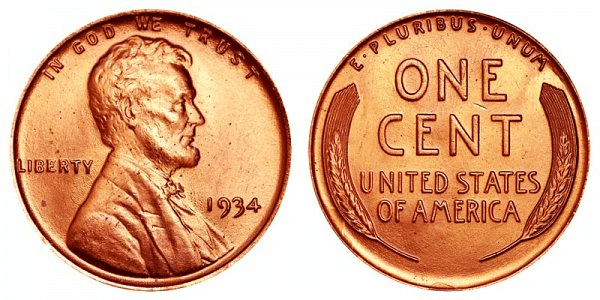
On the obverse, you’ll find the dignified image of Abraham Lincoln, the 16th President of the United States and, perhaps, the most loved president of all time.
Inscriptions on the obverse include the following:
- IN GOD WE TRUST
- LIBERTY
- 1938 (year of minting)
- Mint mark (if present)
On the reverse side, you’ll find the following:
- Two stalks of wheat
- ONE CENT
- E PLURIBUS UNUM
- UNITED STATES OF AMERICA
The coin’s reverse was changed to a design depicting the Lincoln Memorial in 1959, removing the wheat design.
The Lincoln penny was first issued in 1909, the same year Lincoln would have celebrated his centennial birthday. At that time, the Lincoln penny became the first US coin with a face of a US president that became widely circulated.
At the time of the first release of the Lincoln penny, it has gained so much public interest. What made it more interesting was that the US Mint didn’t give any sneak peek into the coin’s novel design. So, on August 2, 1909, it was the first time the public has seen the new cent.
The 1934 penny is an old coin. Thus, many collectors would love to have them on their shelves. However, before you buy a 1934 penny, you should read the rest of this article.
1934 Lincoln Wheat Penny Varieties
The 1934 Lincoln comes in two varieties. There’s no big difference among these varieties except that they have different mint marks. One has a mint mark and the other has none.
Here’s a list of 1938 Lincoln penny varieties and their mintage figure:
| Variety | Mint Location | Mintage |
| 1940 D Lincoln Wheat Penny | Denver | 28,446,000 |
| 1940 P Lincoln Wheat Penny | Philadelphia | 219,080,000 |
| Total | 247,526,000 |
There are more than 247 million pennies struck in 1934. This is a huge increase compared to the mintage figure from the previous year. In 1934, the San Francisco Mint produced no pennies, and there were no proof coins.
Here’s a deeper look at each of the varieties of Lincoln pennies in 1934.
1938 D Lincoln Wheat Penny
Edge: Plain
Mint Mark: D
Place of minting: Denver
Year of minting: 1934
Face Value: $0.01 (one cent)
Price: $0.20 to $3.00 (circulated condition)
Quantity produced: 28,446,000
Designer: Victor David Brenner
Composition: 95% copper and 5% tin and zinc
Mass: 3.11 grams
Diameter: 19.00 mm
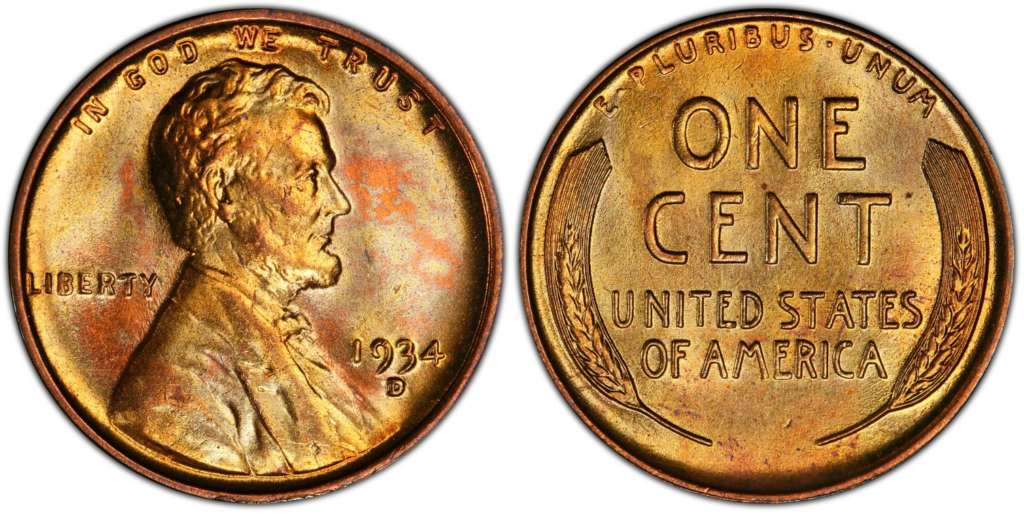
The Denver Mint produced more than 28 thousand pennies in 1934. This is twice as much as what was produced by the same mint center in 1933. A circulated 1934 penny can be around $0.20 to $3.00. However, these pennies can be expensive in the open market.
1934 P Lincoln Wheat Penny
Edge: Plain
Mint Mark: no mint mark
Place of minting: Philadelphia
Year of minting: 1934
Face Value: $0.01 (one cent)
Price: $0.15 to $4 (circulated condition)
Quantity produced: 219,080,000
Designer: Victor David Brenner
Composition: 95% copper and 5% tin and zinc
Mass: 3.11 grams
Diameter: 19.00 mm

The Philadelphia Mint usually produced the most number of pennies and 1934 was no exemption. The mint produced more than 219 million pennies. Compare that to the mintage figure in 1933 which is only 14,360,000.
List Of 1934 Lincoln Wheat Penny Errors
The 1934 wheat penny was produced with great care in mind. The US Mint strove to ensure they produced as many pennies as possible without any mistakes.
However, error coins are things that seem to be unavoidable especially when you think about the massive number of pennies produced each day. For this reason, you would still find 1934 pennies with errors in them.
Error coins may happen due to mechanical or human error. Here are some of the examples of errors you’ll find in the 1934 wheat penny series:
1934 Penny Doubled Die Error
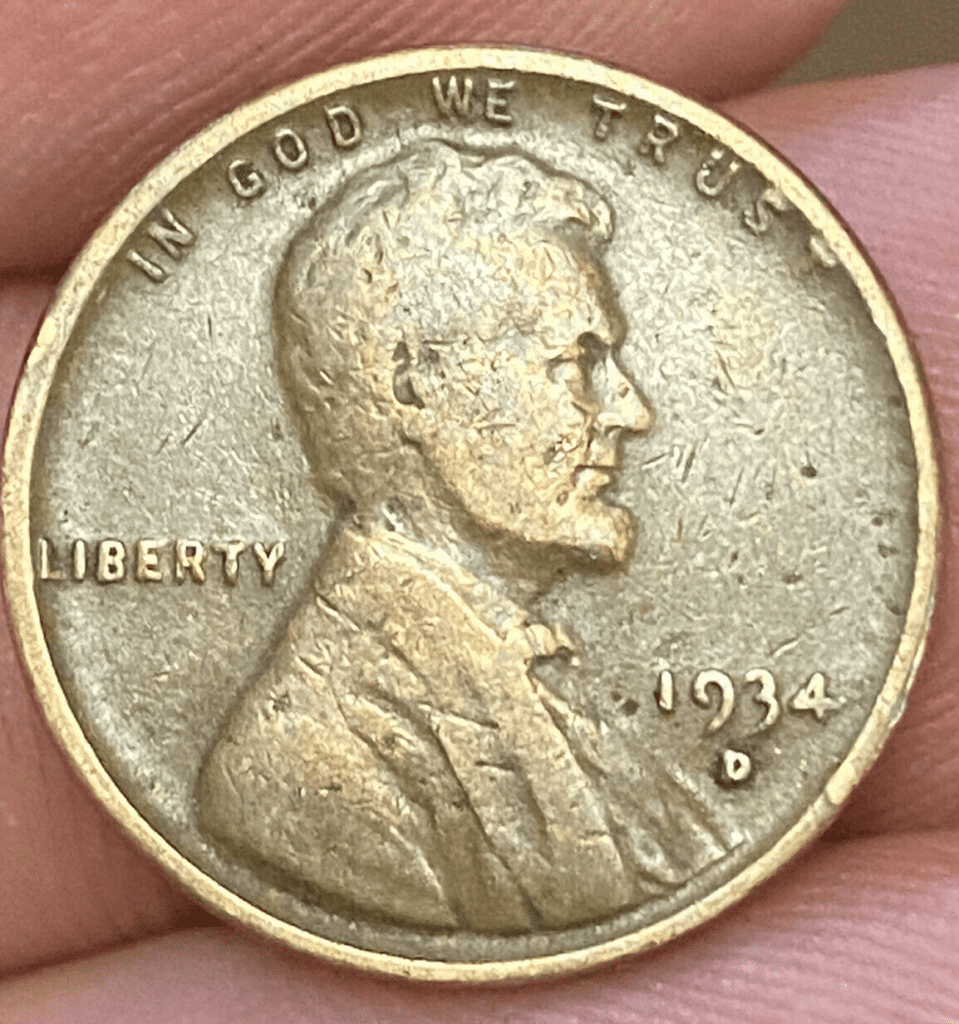
Doubled die errors are common in any year of minting. This happens when the die hits the planchets twice instead of just once. If the error is found on the obverse, it’s called doubled die obverse (DDO). It is called doubled die reverse (DDR) if the error is found on the reverse.
As a result, the 1934 penny looks doubled in some of its engraved elements. Depending on the extent of the error, you should be able to see it with your naked eyes.
In most cases, DDO errors aren’t really obvious. You would even need a microscope or magnifying glass to find them. That’s why the more prominent the error, the more valuable the coin becomes.
1934 Penny Clipped Planchet
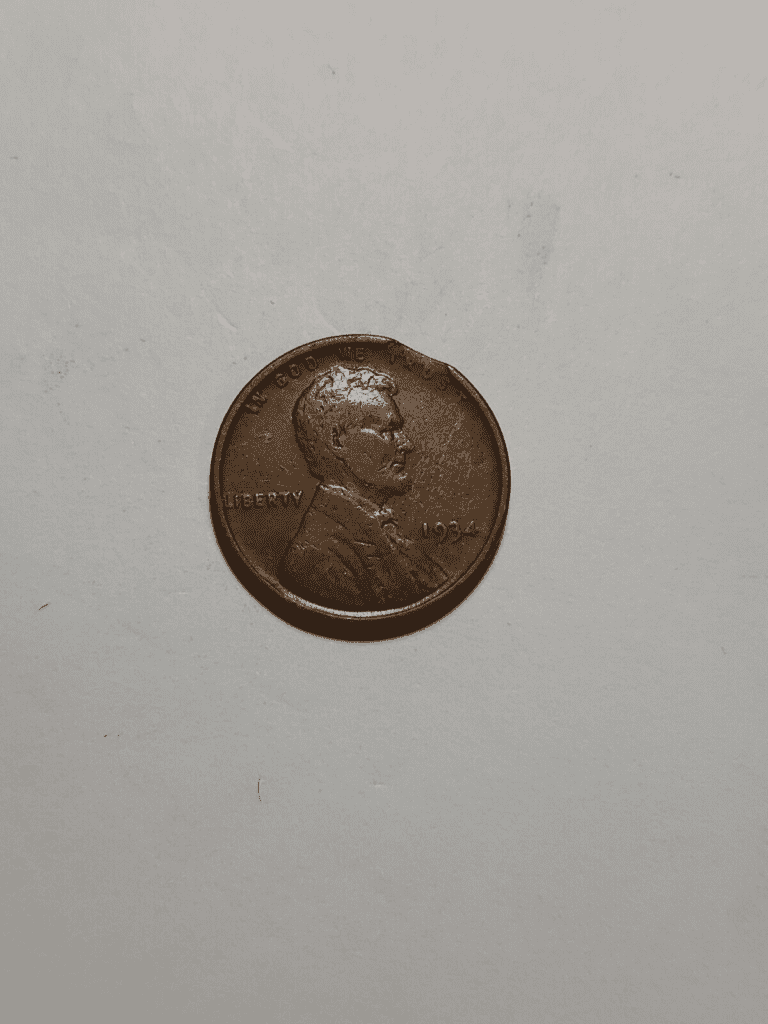
There are times when a coin was incorrectly cut and a portion of it is clipped. It can be clipped or folded.
1934 Penny Lamination Error

Lamination error happens when a foreign material gets in the mix of the coin’s composition. Because this foreign material doesn’t mix well with the rest of the elements, the coin gets cracked, flaked, or discolored.
1934 Penny Thin or Thick Planchet

Sometimes, there’s an error in the cutting process. The planchet was cut too thin or too thick. In the example above, the coin was too thin and lighter than the standard weight.
1934 Penny Repunched Mintmark
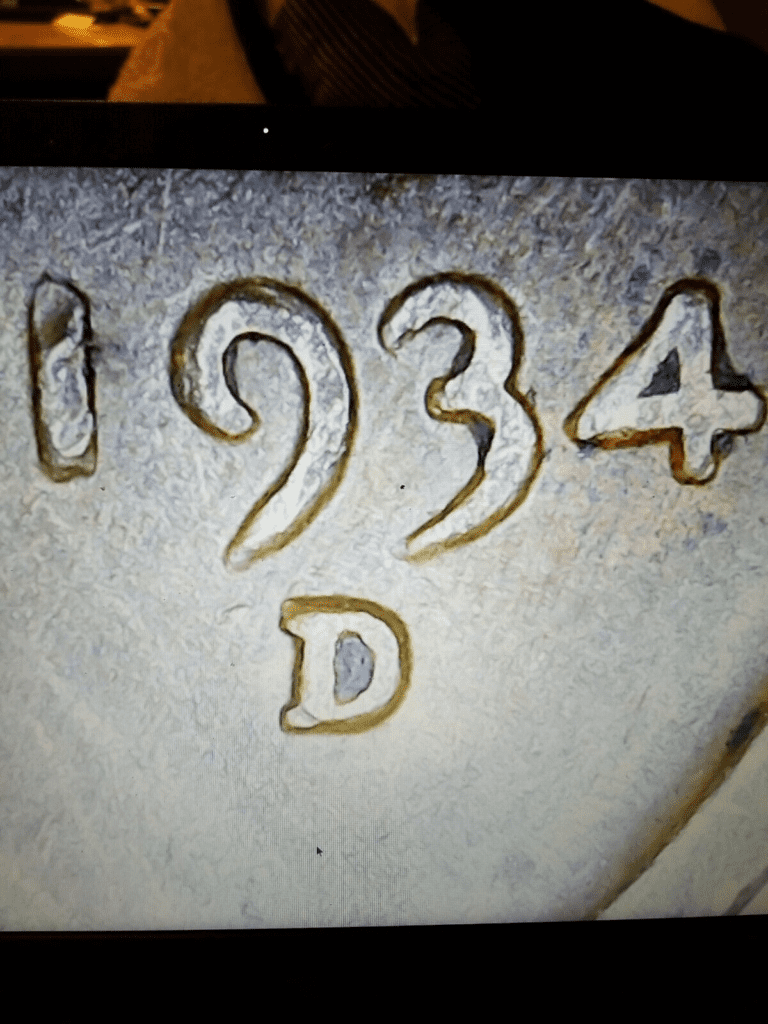
The mint mark is only struck once. However, in RPM errors, the mintmark is struck twice. If the strike was made at a slightly different angle, you’ll see the visible doubling of the mint mark. For the 1934 wheat penny, you would only see this error in coins made in Denver.
How Much Is The 1934 Lincoln Wheat Penny Worth Today?
The 1934 Lincoln penny has a face value of $0.01. Its melt value is $0.0282. The selling price of this coin can be around 4 to 10 dollars if it is in circulated condition. Uncirculated coins, especially those that have been officially graded would be more valuable.
Looking at the face value or melt value, you might think that the Lincoln penny of 1938 isn’t that much.
To know the earning potential for this coin, here’s a 1934 Lincoln Penny values chart of the auction records for each variety:
| Coin | Condition | Grade | Sold date | Sold by | Value |
| 1934 Proof Lincoln Penny | Superb Gem Uncirculated | MS 67+ (Red) | September 2, 2018 | David Lawrence RC | $20,350
|
| 1934 P Lincoln Penny | Superb Gem Uncirculated | MS 68 (Red) | July 26, 2003 | Heritage Auctions | $12,650 |
How Coins are Graded
The Sheldon Scale is used by numismatists to provide a numerical value to coins. The Sheldon Scale goes from poor (P-1) to perfect mint state (P-1) (MS-70). Coins were originally evaluated using words to reflect their condition (Good, Fair, Excellent, Etc.). Unfortunately, coin collectors and dealers had different ideas about what each of these terms represent.
Professional numismatists joined together in the 1970s and established CoinGrading standards. These numismatists now assign grades at key places on the seventy-point scale, using the most regularly utilized numeric points in conjunction with the original adjective grade. The following are the most common coin grades:
- (P-1) Poor – Indistinguishable and probably damaged; if used, must have a date and mintmark; otherwise, rather battered.
- (FR-2) Fair – Nearly smooth, but without the damage that a coin graded Poor often possesses. The coin must have enough detail to be identified.
- (G-4) Fair – Inscriptions have merged into the rims in some areas, and important elements have been mostly erased.
- (VG-8) Very Good- A little weathered, but all of the primary design elements are visible, albeit faintly. There is little if any, central detail left.
- (F-12) Good – The item is very worn, yet the wear is even, and the overall design details stand out clearly. Rims are almost completely isolated from the field.
- (VF-20) Very Fine – Moderately weathered, with some finer features still visible. The motto or all letters of LIBERTY are readable. Both sides of the coin have entire rims that are separated from the field.
- (EF-40) Extremely Fine – Gently used; all gadgets are visible, and the most important ones are bold. The finer details are bold and clear, however, light wear may be seen.
- (AU-50) Uncirculated – Slight evidence of wear on the coin’s design’s high points; may have contact marks; eye appeal should be adequate.
- (AU-58) Uncirculated Choice – Slight traces of wear, no severe contact marks, almost full mint shine, and great eye appeal.
- (MS-60) Mint State Basal – Strictly uncirculated; no indication of wear on the coin’s highest points, but an unsightly coin with reduced luster, visible contact marks, hairlines, and other flaws.
- (MS-63) Mint State Acceptable – Uncirculated, but with contact scratches and nicks, little reduced shine, but otherwise appealing appearance. The strike is weak to average.
- (MS-65) Mint State Choice – Uncirculated with great mint shine, very little contact blemishes, and exceptional eye appeal. The strike is unusually severe.
- (MS-68) Mint State Premium Quality – Uncirculated with superb luster, no obvious contact marks to the naked eye, and exceptional eye appeal. The strike is quick and appealing.
- (MS-69) Almost Perfect Mint State – Uncirculated with perfect brilliance, a sharp and appealing strike, and extremely good eye appeal. A near-perfect coin with minor imperfections in the planchet, strike, and contact markings (seen only under 8x magnification).
- (MS-70) Mint State Perfect – Under 8x magnification, there are no tiny imperfections discernible; the strike is crisp, and the coin is perfectly centered on a beautiful planchet. Rarely seen on a coin, this coin is bright and whole, with original luster and exceptional eye appeal.
Where To Buy Or Sell 1934 Lincoln Wheat Penny?
The 1938 Lincoln penny is available online. A simple Google search should give you numerous results where you can find these pennies.
You can go directly to Amazon, eBay, and Etsy. These online marketplaces can help you buy and sell 1938 Lincoln pennies.
Aside from that, you can go to coin shops, antique stores, and pawnshops. You can also join auctions where some of the rarest 1938 pennies are offered.
If you have the time, join clubs and groups of coin collectors. The more people you know, the more chances you’ll find the right coins for you. You can also try contacting coin-grading service providers such as PCGS and NGC. They can also point you in the right direction.
FAQs
How much is a 1934 wheat penny worth with no mint mark?
The 1934 wheat penny with no mint mark can be around $3. It if is in Gem condition, its value can increase up to $50. The auction record for the 1934 no mint mark penny at the time of this writing is $20,350.
Where is the mint mark on a 1934 wheat penny?
The mint mark on a 1934 wheat penny is found on the obverse side of the coin. You can find it just under the year 1934. You will find a D mint mark on 1934 pennies struck in Denver. No mint mark can be found on coins struck in Philadelphia.
What makes a 1934 wheat penny valuable?
The 1934 wheat penny becomes valuable when it has preserved its original quality. Aside from that, it becomes valuable when it has rare attributes that make it unique.
Is a 1934 wheat penny rare?
There were more than 247 million pennies struck in 1934. So, it is not rare. You should still be able to find these coins in coin shops with relative ease. However, finding 1934 pennies in grades higher than MS 67 would be difficult. The higher the grade, the rarer the penny gets.
